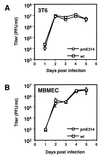In vitro and in vivo characterization of a mouse adenovirus type 1 early region 3 null mutant
- PMID: 10482617
- PMCID: PMC112884
- DOI: 10.1128/JVI.73.10.8640-8646.1999
In vitro and in vivo characterization of a mouse adenovirus type 1 early region 3 null mutant
Abstract
Previous attempts to construct a mouse adenovirus type 1 early region 3 (E3) null mutant by initiator codon mutagenesis were unsuccessful because one of the E3 proteins, gp11K, is synthesized as a fusion protein from a late viral mRNA (A. N. Cauthen and K. R. Spindler, Virology 259:119-128, 1999). Therefore, a different mutagenesis strategy was employed that inserted termination codons into all three reading frames of the E3 proteins. This strategy produced a mutant, pmE314, that was null for the expression of E3 proteins as determined by immunoprecipitation with E3-specific antisera. This mutant grew as well as wild-type (wt) virus in both 3T6 mouse fibroblasts and mouse brain microvascular endothelial cells. However, the 50% lethal dose for pmE314 in adult NIH Swiss outbred mice was approximately 6 log units higher than that of wt virus, indicating that pmE314 was less virulent in mice. In situ hybridization experiments revealed that the absence of the E3 proteins did not alter the tropism of the mutant virus from that of wt virus. When the histopathology was evaluated, the characteristics of the pmE314 infection at both doses administered were strikingly different from those exhibited by wt virus. The central nervous system of wt-infected mice exhibited damage to the endothelium and recruitment of inflammatory cells, whereas the central nervous system of pmE314-infected mice showed no inflammatory response and only mild signs of endothelial damage.
Figures




References
-
- Beard C W, Ball A O, Wooley E H, Spindler K R. Transcription mapping of mouse adenovirus type 1 early region 3. Virology. 1990;175:81–90. - PubMed
-
- Beard C W, Spindler K R. Characterization of an 11K protein produced by early region 3 of mouse adenovirus type 1. Virology. 1995;208:457–466. - PubMed
-
- Cauthen A N, Spindler K R. Construction of mouse adenovirus type 1 mutants. In: Wold W S M, editor. Adenovirus methods and protocols. Totowa, N.J: Humana Press; 1999. pp. 85–103.
-
- Cauthen A N, Spindler K R. Novel expression of mouse adenovirus type 1 early region 3 gp11K at late times after infection. Virology. 1999;259:119–128. - PubMed
Publication types
MeSH terms
Substances
Grants and funding
LinkOut - more resources
Full Text Sources

